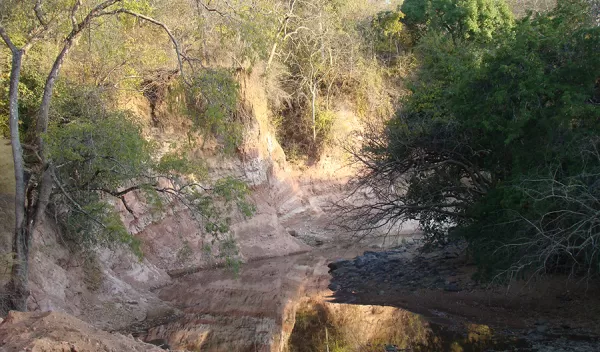
New dinosaur with heart-shaped tail offers clues to evolution of Africa's ecosystems
A dinosaur that wore its "heart" on its tail is providing new clues to how ecosystems evolved on the African continent during the Cretaceous Period some 100 million years ago, according to researchers at Ohio University.
The team reported the new species of dinosaur in a paper published this week in PLOS ONE. The dinosaur, the third found in southwestern Tanzania by the scientists, is a large, long-necked titanosaur, a type of sauropod.
Its partial skeleton was recovered from Cretaceous Period rocks exposed in a cliff surface in the western branch of the East African Rift System.
The dinosaur is named Mnyamawamtuka moyowamkia (Mm-nya-ma-wah-mm-too-ka mm-oh-yo-wa-mm-key-ah). Its name is derived from the Swahili term for "animal of the Mtuka (with) a heart-shaped tail," in reference to the riverbed (Mtuka) in which it was discovered and the unique shape of its tail bones.
"This new dinosaur gives us important information about African fauna during a time of evolutionary change," says Judy Skog, a program director in the National Science Foundation's Division of Earth Sciences, which funded the research. "The finding offers insights into paleogeography during the Cretaceous. It's also a timely report of an animal with heart-shaped tail bones during this week of Valentine's Day."
The initial discovery of M. moyowamkia happened in 2004, when part of the skeleton was discovered high in a cliff wall overlooking the seasonally dry Mtuka riverbed, with excavations continuing through 2008.
"Although titanosaurs became one of the most successful dinosaur groups before the mass extinction capping the Age of Dinosaurs, their early evolutionary history remains obscure, and Mnyamawamtuka helps reveal those beginnings," said lead author Eric Gorscak of the Midwestern College of Osteopathic Medicine.
"The wealth of information from the skeleton indicates that it was distantly related to other known African titanosaurs, except for some interesting similarities with another dinosaur, Malawisaurus, from just across the Tanzania-Malawi border."
Titanosaurs are best known from Cretaceous rocks in South America, but efforts by the team include new titanosaur species discovered in Tanzania, Egypt and other parts of the African continent. They reveal a complex picture of dinosaur evolution.
"The discovery of dinosaurs like Mnyamawamtuka is like doing a four-dimensional connect-the-dots," said senior author Patrick O'Connor of Ohio University. "Each new discovery adds a bit more detail to the picture of what ecosystems in Africa were like during the Cretaceous, allowing us to assemble a more holistic view of biotic change in the past."
The excavation process spanned several years, and included researchers suspended by ropes and large-scale mechanical excavators to recover one of the more complete specimens from this part of the sauropod dinosaur family tree.
"Without the dedication of several field teams, including some whose members donned climbing gear for the early excavations, the skeleton would have eroded away into the river during intense wet seasons in this part of the East African Rift System," said O'Connor.
M. moyowamkia and other Tanzanian titanosaurs are not the only animals discovered by the research team. Remains of bizarre relatives of early crocodiles, the oldest evidence for "insect farming," and tantalizing clues about the early evolution of monkeys and apes have been found.
These discoveries from the East African Rift System, the scientists say, provide a glimpse into the ancient ecosystems of Africa, and provide the impetus for future work elsewhere on the continent.
The study was also funded by the National Geographic Society, the Jurassic Foundation, the Paleontological Society, Ohio University Student Enhancement Award, Ohio University Original Work Grant, the Ohio University Heritage College of Osteopathic Medicine, and the Ohio University Office of the Vice President for Research and Creative Activity.


